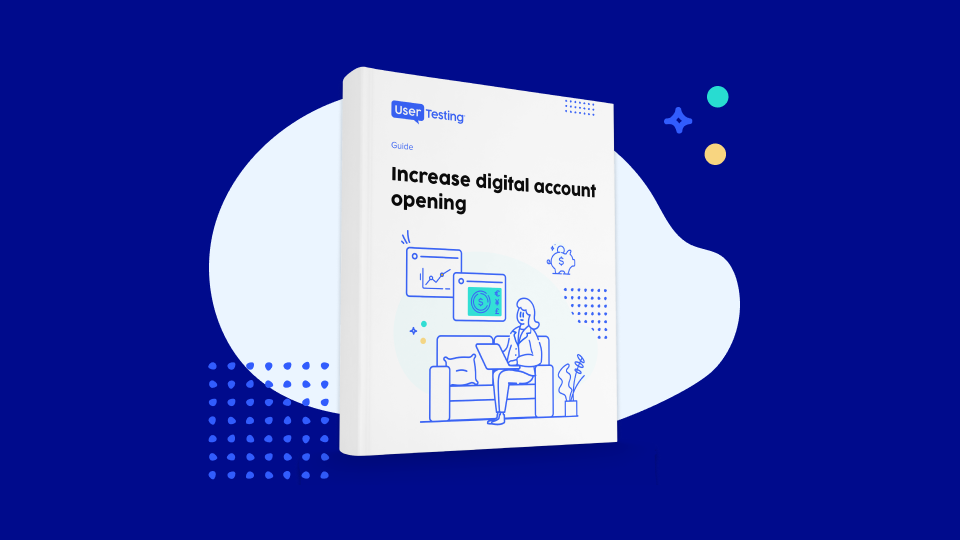
Create great banking onboarding experiences

What was the best onboarding experience you ever had? While this can depend on the software and product, what typically comes to mind is one that was minimalistic, straightforward, and quick. From starting a new role and getting acquainted with organizational software to signing up for a new app, you’ve likely done some form of onboarding in your digital lifetime. And with the average American having approximately 80 mobile apps, you probably already have a good idea of what you don’t want in an onboarding experience.
Every second, banks lose potential customers to clunky and frustrating digital onboarding processes. With 60% of prospective customers in North America and 68% in Europe abandoning digital account openings, traditional banks face growing pressure from fintechs and neobanks.
Some customers may have various financial apps for individual needs, from banking and budgeting to stock trading and advising. Meanwhile, another may prefer a service that includes all of the above. With onboarding fatigue and churn on the line, ensure your financial product is one that customers will successfully register for and keep coming back.
To bridge the gap between the challenges traditional banks face and the importance of seamless onboarding, consider what sets successful digital experiences apart. The most effective onboarding flows prioritize clarity, ease of use, and personalization. Customers expect a frictionless journey—one that minimizes redundant steps, avoids unnecessary data entry, and provides immediate value.
In a competitive market where attention spans are short, even small inconveniences can drive users away. By streamlining processes and offering guided, intuitive interactions, financial institutions can turn potential drop-offs into long-term relationships.
ON-DEMAND WEBINAR
From friction to conversion: optimizing digital bank account opening with customer insights
Here are the best practices to follow and three examples to use as inspiration for better onboarding.
How top financial service organizations are leading the way for onboarding
1. Consistency across multiple channels
It can be challenging to replicate desktop pages character by character on mobile, thanks to sizing and layout differences, among others. However, you can’t predict a user’s preference, and maintaining consistent experiences across devices can solidify your organization's reliability and trustworthiness. Differences across channels can pertain to visuals or messaging. For example, a desktop onboarding process could offer an option for one to access an incomplete application but not offer the same on mobile. This can lead the customer to think that the desktop experience is prioritized or better, which can be an automatic inconvenience if one prefers mobile onboarding.
Credit Karma puts this in good practice with their account creation page. On mobile and desktop, their information is consistent, including matching progress bars, copy, CTAs, and advertising. There are no discrepancies, and you’ll know what you’re getting no matter which device you’re on.
2. Avoid asking customers the same questions repeatedly
When applying for a new role, you’ve likely encountered the frustration of uploading your resume only to be asked to manually fill out your educational and professional background field by field. Avoid this experience for new customers by only asking the mandatory questions first and just once.
T. Rowe Price offers a visually appealing sign-up page for new users that comes with minimal scrolling. The process doesn’t repeat any questions, and any repeated fields come pre-filled with the information you’ve already entered, so you don’t have to duplicate any typing. And while financial account registration can seem like it requires a laundry list of mandatory information, opening a Roth IRA with T. Rowe Price entails just five steps to start.
3. Provide process and timeline transparency
With the number of accounts we sign up for and apps we download daily, it’s easy to feel registration fatigue. Relieve potential customers by being upfront about how long the onboarding process will take.
Bank of America gets this right for users opening an account online. From the start, users are told that the process will take about 10 minutes, but that’s not all. If someone is an existing customer but opening a new account, they can have their information pre-filled to save time. Additionally, users don’t have to feel pressured to finish all in one sitting as they can save their work and finish later. Each section is also complete with a progress bar and labeled, so there are clear expectations about what’s left.
4. Offer a diverse knowledgebase that answers all questions
Sometimes, users will get stuck in the onboarding process, and organizations must anticipate this need. Financial service providers should offer helpful content that answers questions instead of creating more and catering to different learning preferences. Ideally, knowledgebases should provide sufficient information so users can rely on call and support centers as a last resort.
Square is a prime example and offers an extensive knowledgebase of help articles and videos all in one place. Complete with a table of contents and drop-down menus, the page is categorized by section so users can either reach out to support centers, get in-app support, or collaborate with others in the Seller Community. Square acknowledges that some may prefer reading help articles while others enjoy watching support videos instead, so they offer both options.
And knowing that they can’t predict every user need, Square offers a space to give user feedback about one’s support experience, and the help article in general. Finally, if you still have questions, users can scroll to the bottom to chat with a support assistant.
How to implement user feedback into customer onboarding
You don’t know if you don’t ask. Prevent blind spots by weaving user feedback into your onboarding development process to get instant visibility into where the friction lies. For example, if you want to ensure your interactive tutorial contains all the right information, run a few quick user tests and see if users understand what to do after they complete it. If you send a series of email lessons, read the replies.
Here are the best practices to add to your checklist.
- Strike while the iron’s hot: Make the most of your human-to-human time by collaborating on the product and workshopping on real projects
- Have everyone in the room (at just the right times): Ensure value for your customers by inviting just the right people to the appropriate touchpoints and ensure everyone understands the role they play
- Make space for conversation, collaboration, and contrarians: While video tutorials and help center articles are a necessary component for onboarding, discussing questions and concerns in person will increase the likelihood of retention
The future of customer onboarding
Pulkit Agrawal, Co-founder and CEO of Chameleon, sat down with UserTesting on the Human Insight Podcast to discuss onboarding. He says, “I think one of the things that’s really exciting is the ability to do real-time automated, dynamic user experience. I think what we can do is get to a place where it’s very personal.”
Watch the video below for more of Agrawal’s take on the future of onboarding.

Turning first impressions into lasting relationships
A seamless onboarding experience can make or break a customer’s relationship with a financial service provider. With high abandonment rates in digital account openings, organizations must prioritize consistency, efficiency, and transparency to ensure users complete the process. The best onboarding flows reduce friction by maintaining uniformity across devices, eliminating redundant steps, setting clear expectations, and offering robust support. By focusing on these best practices, financial institutions can turn a frustrating necessity into a smooth and engaging experience that keeps customers coming back.
Seamless onboarding builds trust. Keep it consistent, intuitive, and transparent—so customers stay, not stray. #UserExperience #Fintech
To illustrate these key takeaways, we’ve put together an infographic that highlights the essential strategies and real-world examples of top financial service organizations leading the way in onboarding. Check it out below for a quick-reference guide to optimizing your customer journey.
Infographic: From friction to flow


Improve digital bank account opening experiences
Innovate and optimize digital banking experiences with this comprehensive onboarding guide.





